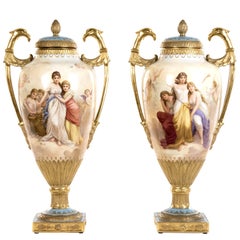Portraits Back Of Women
to
1
1
1
Sort By
Pair of Empire Portrait Urns by Royal Vienna
By Royal Vienna Porcelain
Located in Salt Lake City, UT
-head handles and each hand-painted on the front and back with idyllic portraits of women surrounded by
Category
Antique 19th Century French Neoclassical Revival Urns
Materials
Porcelain
Get Updated with New Arrivals
Save "Portraits Back Of Women", and we’ll notify you when there are new listings in this category.
Portraits Back Of Women For Sale on 1stDibs
Find a variety of portraits back of women available on 1stDibs. Browse a selection of contemporary, modern or Pop Art versions of these works for sale today — there are 744 contemporary, 164 modern, 70 abstract, 55 Impressionist and 46 Pop Art examples available. These items have been produced for many years, with earlier versions available from the 18th Century and newer variations made as recently as the 21st Century. You can search the portraits back of women that we have for sale on 1stDibs by color — popular works were created in bold and neutral palettes with elements of gray, black, brown and blue. These artworks have been a part of the life’s work for many artists, but the versions made by Kirsten Thys van den Audenaerde, Stefanie Schneider, Clare Marie Bailey, Indira Cesarine and Sally K are consistently popular. The range of these distinct pieces — often created in paint, paper and oil paint — can elevate any room of your home.
How Much are Portraits Back Of Women?
Prices for art of this kind can differ depending upon size, time period and other attributes — portraits back of women in our inventory begin at $94 and can go as high as $295,643, while the average can fetch as much as $1,759.
